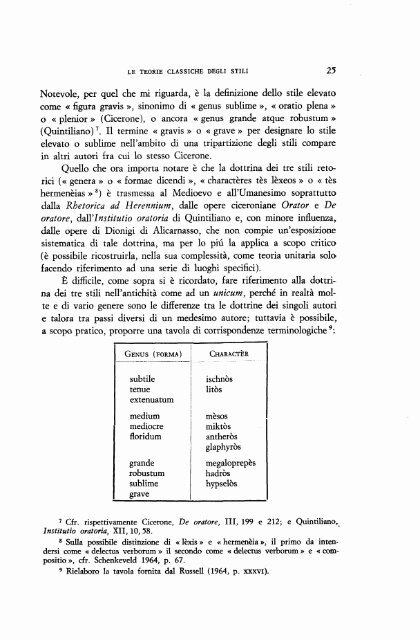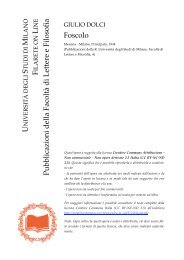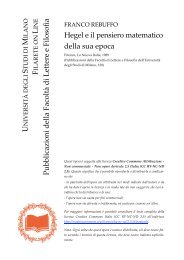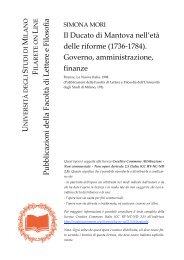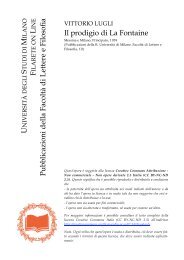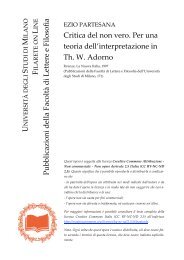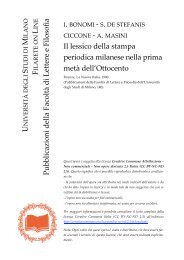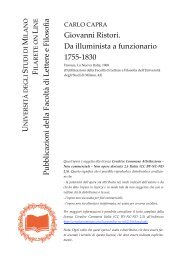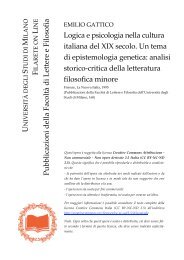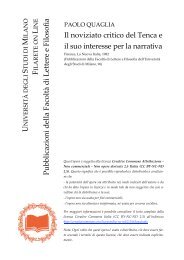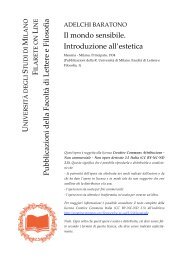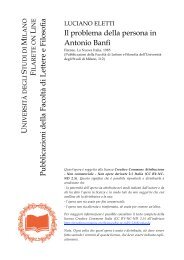- Page 1 and 2: UNIVERSITÀ
DEGLI
STUDI
DI
- Page 3 and 4: HERMANN GROSSER LA SOTTIGLIEZZA DEL
- Page 5: A Emilio Bigi
- Page 8 and 9: X INDICE 3.4. Ermogene e lo pseudo-
- Page 11 and 12: INTRODUZIONE Quella stagione del Ri
- Page 13 and 14: INTRODUZIONE tardi, ma con incidenz
- Page 15 and 16: INTRODUZIONE sulla codificazione de
- Page 17 and 18: INTRODUZIONE vita », così com'è
- Page 19 and 20: INTRODUZIONE incidenza dell'imitazi
- Page 21 and 22: INTRODUZIONE 11 nuova temperie cult
- Page 23 and 24: INTRODUZIONE 13 di fatto nella Conq
- Page 25 and 26: INTRODUZIONE 15 cessiva e ancor pi
- Page 27 and 28: INTRODUZIÓNE 17 il Tasso non oser
- Page 29: INTRODUZIONE 19 tenza di questo stu
- Page 33: CAPITOLO 1 LE TEORIE CLASSICHE DEGL
- Page 37 and 38: LE TEORIE CLASSICHE DEGLI STILI 27
- Page 39 and 40: LE TEORIE CLASSICHE DEGLI STILI 29
- Page 41 and 42: LE TEORIE CLASSICHE DEGLI STILI 31
- Page 43 and 44: LE TEORIE CLASSICHE DEGLI STILI 33
- Page 45 and 46: LE TEORIE CLASSICHE DEGLI STILI 35
- Page 47 and 48: LE TEORIE CLASSICHE DEGLI STILI 37
- Page 49 and 50: LE TEORIE CLASSICHE DEGLI STILI 39
- Page 51 and 52: ERMOGENE 1. saphèneia 2. mègethos
- Page 53 and 54: LE TEORIE CLASSICHE DEGLI STILI 43
- Page 55 and 56: LE TEORIE CLASSICHE DEGLI STILI 45
- Page 57 and 58: LE TEORIE CLASSICHE DEGLI STILI del
- Page 59 and 60: LE TEORIE CLASSICHE DEGLI STILI 49
- Page 61 and 62: LE TEORIE CLASSICHE DEGLI STILI 51
- Page 63 and 64: CAPITOLO 2 LE TEORIE DEGLI STILI IN
- Page 65 and 66: LE TEORIE DEGLI STILI IN ETÀ RINAS
- Page 67 and 68: LE TEORIE DEGLI STILI IN ETÀ RINAS
- Page 69 and 70: LE TEORIE DEGLI STILI IN ETÀ RINAS
- Page 71 and 72: LE TEORIE DEGLI STILI IN ETÀ RINAS
- Page 73 and 74: LE TEORIE DEGLI STILI IN ETÀ RINAS
- Page 75 and 76: LE TEORIE DEGLI STILI IN ETÀ RINAS
- Page 77 and 78: LE TEORIE DEGLI STILI IN ETÀ RINAS
- Page 79 and 80: LE TEORIE DEGLI STILI IN ETÀ RINAS
- Page 81 and 82: LE TEORIE DEGLI STILI IN ETÀ RINAS
- Page 83 and 84: LE TEORIE DEGLI STILI IN ETÀ RINAS
- Page 85 and 86:
LE TEORIE DEGLI STILI IN ETÀ RINAS
- Page 87 and 88:
LE TEORIE DEGLI STILI IN ETÀ RINAS
- Page 89 and 90:
LE TEORIE DEGLI STILI IN ETÀ RINAS
- Page 91 and 92:
LE TEORIE DEGLI STILI IN ETÀ RINAS
- Page 93 and 94:
LE TEORIE DEGLI STILI IN ETÀ RINAS
- Page 95 and 96:
LE TEORIE DEGLI STILI IN ETÀ RINAS
- Page 97 and 98:
LE TEORIE DEGLI STILI IN ETÀ RINAS
- Page 99 and 100:
LE TEORIE DEGLI STILI IN ETÀ RINAS
- Page 101 and 102:
LE TEORIE DEGLI STILI IN ETÀ RINAS
- Page 103 and 104:
LE TEORIE DEGLI STILI E LA TEORIA D
- Page 105 and 106:
LE TEORIE DEGLI STILI E LA TEORIA D
- Page 107 and 108:
LE TEORIE DEGLI STILI E LA TEORIA D
- Page 109 and 110:
LE TEORIE DEGLI STILI E LA TEORIA D
- Page 111 and 112:
LE TEORIE DEGLI STILI E LA TEORIA D
- Page 113 and 114:
LE TEORIE DEGLI STILI E LA TEORIA D
- Page 115 and 116:
LE TEORIE DEGLI STILI E LA TEORIA D
- Page 117 and 118:
LE TEORIE DEGLI STILI E LA TEORIA D
- Page 119 and 120:
LE TEORIE DEGLI STILI E LA TEORIA D
- Page 121 and 122:
LE TEORIE DEGLI STILI E LA TEORIA D
- Page 123 and 124:
LE TEORIE DEGLI STILI E LA TEORIA D
- Page 125 and 126:
LE TEORIE DEGLI STILI E LA TEORIA D
- Page 127 and 128:
LE TEORIE DEGLI STILI E LA TEORIA D
- Page 129 and 130:
LE TEORIE DEGLI STILI E LA TEORIA D
- Page 131 and 132:
LE TEORIE DEGLI STILI E LA TEORIA D
- Page 133 and 134:
LE TEORIE DEGLI STILI E LA TEORIA D
- Page 135 and 136:
LE TEORIE DEGLI STILI E LA TEORIA D
- Page 137 and 138:
Categorie Concetti . . . parole (lo
- Page 139 and 140:
LE TEORIE DEGLI STILI E LA TEORIA D
- Page 141 and 142:
LE TEORIE DEGLI STILI E LA TEORIA D
- Page 143 and 144:
LE TEORIE DEGLI STILI E LA TEORIA D
- Page 145 and 146:
LE TEORIE DEGLI STILI E LA TEORIA D
- Page 147 and 148:
LE TEORIE DEGLI STILI E LA TEORIA D
- Page 149 and 150:
LE TEORIE DEGLI STILI E LA TEORIA D
- Page 151 and 152:
141 « parole » e trascurando gli
- Page 153 and 154:
LE TEORIE DEGLI STILI E LA TEORIA D
- Page 155 and 156:
LE TEORIE DEGLI STILI E LA TEORIA D
- Page 157 and 158:
LE TEORIE DEGLI STILI E LA TEORIA D
- Page 159 and 160:
LE TEORIE DEGLI STILI E LA TEORIA D
- Page 161 and 162:
LE TEORIE DEGLI STILI E LA TEORIA D
- Page 163 and 164:
LE TEORIE DEGLI STILI E LA TEORIA D
- Page 165 and 166:
LE TEORIE DEGLI STILI E LA TEORIA D
- Page 167:
PARTE SECONDA
- Page 170 and 171:
160 CAPITOLO 4 coce del ' suo ' poe
- Page 172 and 173:
162 CAPITOLO 4 lezione più moderna
- Page 174 and 175:
164 CAPITOLO 4 e tre i teorici cita
- Page 176 and 177:
166 CAPITOLO 4 a se stesso è drast
- Page 178 and 179:
168 CAPITOLO 4 come sono in dirczio
- Page 180 and 181:
170 CAPITOLO 4 demente 19 . Afferma
- Page 182 and 183:
172 CAPITOLO 4 È chiaro, dopo quan
- Page 184 and 185:
174 CAPITOLO 4 nonché della Lezion
- Page 186 and 187:
176 CAPITOLO 4 lici, or lieti, or c
- Page 188 and 189:
178 CAPITOLO 4 una precisazione sig
- Page 190 and 191:
180 CAPITOLO 4 la catena logica lin
- Page 192 and 193:
182 CAPITOLO 4 dei diversi stili, d
- Page 194 and 195:
184 CAPITOLO 4 dei modelli non rece
- Page 196 and 197:
186 CAPITOLO 4 venibili elementi di
- Page 198 and 199:
188 CAPITOLO 4 tario, e la sua gene
- Page 200 and 201:
190 CAPITOLO 4 il trattato del reto
- Page 202 and 203:
192 CAPITOLO 4 II Tasso poteva deri
- Page 204 and 205:
194 CAPITOLO 4 pare quasi ridisegna
- Page 206 and 207:
196 CAPITOLO 4 le, postulando quasi
- Page 208 and 209:
198 CAPITOLO 4 Ebbene, se pensiamo
- Page 210 and 211:
200 CAPITOLO 4 cazione dell'epico.
- Page 212 and 213:
202 CAPITOLO 4 fica che i tre gener
- Page 214 and 215:
204 CAPITOLO 4 del tentativo di com
- Page 216 and 217:
2'06 CAPITOLO 4 Demeliio, tanto del
- Page 218 and 219:
208 CAPITOLO 4 la tesi il Tasso pro
- Page 220 and 221:
210 CAPITOLO 4 « come questa magni
- Page 222 and 223:
212 CAPITOLO 4 metrio indica esplic
- Page 224 and 225:
214 CAPITOLO 4 conseguisce lo scrit
- Page 226 and 227:
216 CAPITOLO 4 seguitato a meditare
- Page 228 and 229:
218 CAPITOLO 4 Che quella specifica
- Page 230 and 231:
220 CAPITOLO 4 stile, che il Tasso
- Page 232 and 233:
CAPITOLO 5 IL PROBLEMA DELLO STILE
- Page 234 and 235:
224 CAPITOLO 5 contrario a i precet
- Page 236 and 237:
226 CAPITOLO 5 È chiaro, con ogni
- Page 238 and 239:
228 CAPITOLO 5 A proposito di quest
- Page 240 and 241:
230 CAPITOLO 5 (« il lasciar l'aud
- Page 242 and 243:
232 CAPITOLO 5 maticamente rivolti
- Page 244 and 245:
234 CAPITOLO 5 e il suo pubblico, e
- Page 246 and 247:
236 CAPITOLO 5 impasti stilistici c
- Page 248 and 249:
238 CAPITOLO 5 scono « da' sensi
- Page 250 and 251:
240 CAPITOLO 5 Una svolta almeno pa
- Page 252 and 253:
242 CAPITOLO 5 ' della materia, dei
- Page 254 and 255:
244 CAPITOLO 5 se forse non sono co
- Page 256 and 257:
246 CAPITOLO 5 una forma stilistica
- Page 258 and 259:
248 CAPITOLO 5 Né stupisce che cir
- Page 260 and 261:
250 CAPITOLO 5 lativamente marginal
- Page 262 and 263:
252 CAPITOLO 5 mente rimanda alle t
- Page 264 and 265:
254 CAPITOLO 5 ha connotati quasi d
- Page 266 and 267:
256 CAPITOLO 5 canzoniere petrarche
- Page 268 and 269:
258 CAPITOLO 5 così virulenta, cer
- Page 270 and 271:
260 CAPITOLO 5 a far che la mia elo
- Page 272 and 273:
262 CAPITOLO 5 in esame un decennio
- Page 274 and 275:
264 CAPITOLO 5 cimi importanti arti
- Page 276 and 277:
266 CAPITOLO 5 cessarla della magni
- Page 278 and 279:
268 CAPITOLO 5 sono un'espansione d
- Page 280 and 281:
270 CAPITOLO 5 epico, il quale come
- Page 282 and 283:
272 CAPITOLO 5 Ma se molte sono l'i
- Page 284 and 285:
274 CAPITOLO 5 (« il vii amor d'an
- Page 286 and 287:
276 CAPITOLO 5 la prudenza del poet
- Page 288 and 289:
278 CAPITOLO 5 nuovo sarà il poema
- Page 290 and 291:
280 CAPITOLO 5 sempre — della pos
- Page 292 and 293:
282 CAPITOLO 5 ne, ne seguirebbe ch
- Page 294 and 295:
284 CAPITOLO 5 distante da quello d
- Page 296 and 297:
286 CAPITOLO 5 chiama allo schema s
- Page 298 and 299:
288 CAPITOLO 5 di Ermogene (e in mi
- Page 300 and 301:
290 CAPITOLO 5 conformemente al mod
- Page 302 and 303:
292 CAPITOLO 5 stinti nella success
- Page 304 and 305:
294 CAPITOLO 5 «del poema eroico c
- Page 306 and 307:
296 CAPITOLO 5 e il « grande », i
- Page 308 and 309:
298 CAPITOLO 5 convenevolezza da mo
- Page 310 and 311:
300 CAPITOLO 5 carattere solamente,
- Page 312 and 313:
302 CONCLUSIONI i teorici a cercare
- Page 314 and 315:
304 CONCLUSIONI processo significas
- Page 316 and 317:
306 CONCLUSIONI € valutarne il se
- Page 318 and 319:
308 CONCLUSIONI deo, che inclina a
- Page 320 and 321:
310 BIBLIOGRAFIA GENERALE Ariani 19
- Page 322 and 323:
312 BIBLIOGRAFIA GENERALE Bigi 1967
- Page 324 and 325:
314 BIBLIOGRAFIA GENERALE Cottaz 19
- Page 326 and 327:
316 BIBLIOGRAFIA GENERALE Durling 1
- Page 328 and 329:
318 BIBLIOGRAFIA GENERALE in onore
- Page 330 and 331:
320 BIBLIOGRAFIA GENERALE Michel 19
- Page 332 and 333:
322 BIBLIOGRAFIA GENERALE Quondam 1
- Page 334 and 335:
324 BIBLIOGRAFIA GENERALE Scarpati
- Page 336 and 337:
326 BIBLIOGRAFIA GENERALE ed illust
- Page 338 and 339:
328 BIBLIOGRAFIA GENERALE Weise 195


